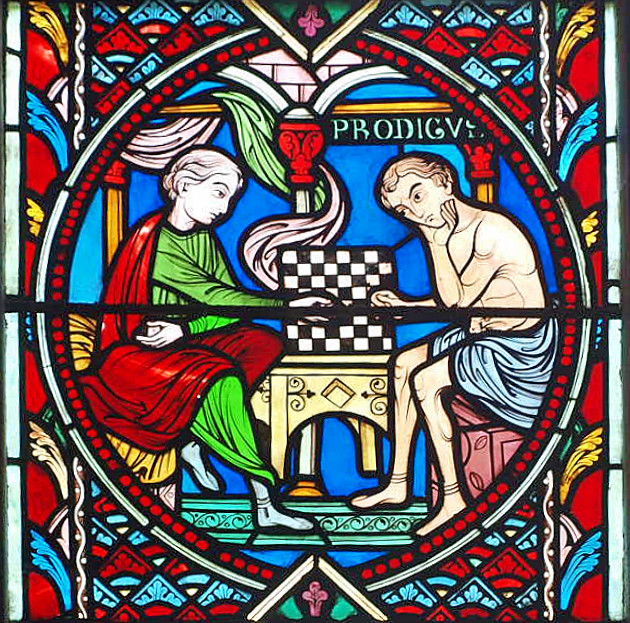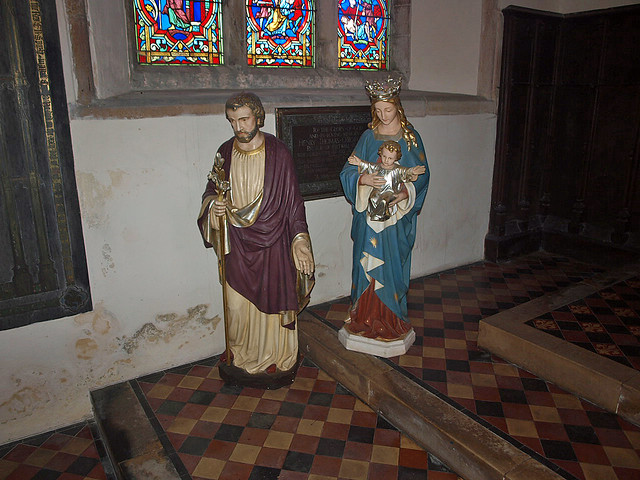ST MARY. An indulgence was offered in 1494 for money to repair the church. Sumptuous Perp W tower with double-stepped openwork parapet and pinnacles. Dec chancel with a big five-light E window and reticulated side windows. Dec sedilia and piscina of large, somewhat raw forms. The ogee heads have a flat top, i.e. are slightly truncated. Dec S arcade of five bays. The piers have four major and in the diagonals four minor shafts. Arches with sunk wave mouldings. The S aisle has big Perp windows with stepped embattled transoms. The N side, including the lush arcade and the even lusher arcade of the N chapel, is all of 1861-3. - SCREEN. Only very partially old. The design, if reliable, is unusual. - BENCHES. A fine set with low backs pierced with different tracery patterns, and poppy-heads on the ends. On the armrests little animals and also groups of two figures. - STALLS. Partly original, with poppy-heads. - STAINED GLASS. Much by Didron of Paris, dated 1860-3. In the C13 style. - PLATE. Dish, 1837; Chalice, undated. - MONUMENTS. Brasses to Francis Hetht d. 1479 (13 in. figure) and to Margaret Mundford d. 1520 (18 in. figure; both chancel, S wall). - Tablets with small kneeling figures to Francis Moundeford d. 1590 and to Osbert Moundeford d. 1580 and two wives. - Large Brass to the Rev. William Newcome d. 1846, in the Pugin style (chancel, N wall).
FELTWELL. Two old churches greet each other in this big village, which has a common on its western side and a giant oak where the road goes east.
The church of St Nicholas, the smaller and older of the two, stands high at one end of the village, and is now used only for burials. It looks to St Mary’s 15th-century tower, and if stones can feel it must have sad memories of its own tower, which collapsed last century. It was a round Norman tower with a 15th-century belfry, and all that is left of it is the boarded-up Norman arch which led to it. Only the porch, nave, and aisles are left of the church, coming chiefly from the 14th and 15th century. The arcades have clustered pillars, and set in the wall is a Norman pillar carved with zigzag.
St Mary’s 15th-century flint tower rises proudly with its pinnacles above the red roofs of the cottages, and the great house is at its side. Most of the church is 500 years old. The old nave roof has carved beams with ten robed figures and ten oak angels looking down on a fine array of old benches. There are more than 30 of them, all with leaf poppyheads, though most of the animals which used to crouch below them are gone. All have charming backs of open tracery and dainty ornament on the rails, and among the carvings on some of the arm-rests are three children standing by a figure tied up in a shroud, a belted figure with a bag, and a face peeping from a window. Some stout old benches in the chancel have fine foliage poppyheads; the oak screen (chiefly new) is richly carved with canopies and minstrel angels; a desk in the sanctuary is enriched with carved Bible scenes. The chancel and the chapel are dim with stained glass, most of it French, showing small scenes of Bible story.
On a stone wall monument with a shallow canopy are the 16th-century figures of Osbert Moundeford and his two wives, he in gilt-edged armour with his helmet in front of him, and all kneeling on red cushions. Francis, his son, is a tiny figure also in gilt-edged armour, kneeling on a cushion with his helmet. A fine little brass portrait shows Margaret Moundeford with her hands at prayer, wearing a gown with a girdle held by a heart clasp, from which hang her purse, her pomander box, and beads. Another fine brass shows Francis Hethe of 1479, a youthful figure in armour, at prayer.
The church of St Nicholas, the smaller and older of the two, stands high at one end of the village, and is now used only for burials. It looks to St Mary’s 15th-century tower, and if stones can feel it must have sad memories of its own tower, which collapsed last century. It was a round Norman tower with a 15th-century belfry, and all that is left of it is the boarded-up Norman arch which led to it. Only the porch, nave, and aisles are left of the church, coming chiefly from the 14th and 15th century. The arcades have clustered pillars, and set in the wall is a Norman pillar carved with zigzag.
St Mary’s 15th-century flint tower rises proudly with its pinnacles above the red roofs of the cottages, and the great house is at its side. Most of the church is 500 years old. The old nave roof has carved beams with ten robed figures and ten oak angels looking down on a fine array of old benches. There are more than 30 of them, all with leaf poppyheads, though most of the animals which used to crouch below them are gone. All have charming backs of open tracery and dainty ornament on the rails, and among the carvings on some of the arm-rests are three children standing by a figure tied up in a shroud, a belted figure with a bag, and a face peeping from a window. Some stout old benches in the chancel have fine foliage poppyheads; the oak screen (chiefly new) is richly carved with canopies and minstrel angels; a desk in the sanctuary is enriched with carved Bible scenes. The chancel and the chapel are dim with stained glass, most of it French, showing small scenes of Bible story.
On a stone wall monument with a shallow canopy are the 16th-century figures of Osbert Moundeford and his two wives, he in gilt-edged armour with his helmet in front of him, and all kneeling on red cushions. Francis, his son, is a tiny figure also in gilt-edged armour, kneeling on a cushion with his helmet. A fine little brass portrait shows Margaret Moundeford with her hands at prayer, wearing a gown with a girdle held by a heart clasp, from which hang her purse, her pomander box, and beads. Another fine brass shows Francis Hethe of 1479, a youthful figure in armour, at prayer.



No comments:
Post a Comment